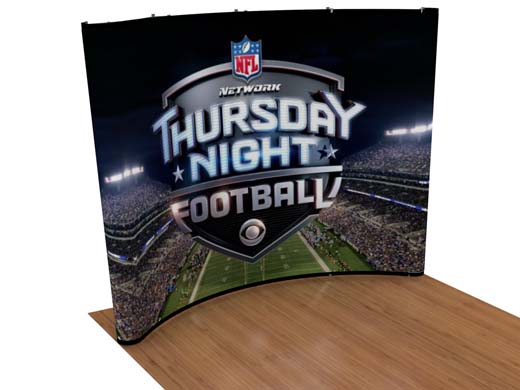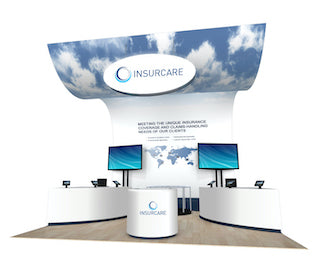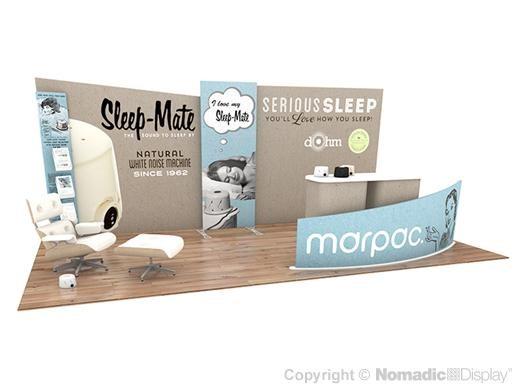The one thing most exhibits still get wrong—and 6 ways to fix it.
For all the talk about ROI, brand presence, and cutting through the noise, there’s one question too many teams still can’t answer:
“What are we actually asking people to do once they step into our exhibit?”
Not in theory. In the real moment—when someone’s passing by, scanning for what feels relevant, and deciding whether your space is worth their time.
That moment moves fast. And most exhibits don’t make it past the first glance.
Because while the display may be professionally designed, beautifully lit, and backed by a solid team—there’s often no interaction. No built-in action. No clear reason to pause, stay, or explore.
And that’s not just a design miss. That’s a strategic gap.
The best exhibits don’t just look good. They do something. They invite people to participate, to explore, to connect in a way that feels human and grounded. Not flashy. Not forced. Just real.
And right now, interaction matters more than ever.
We’re all designing for a more selective audience. People are used to skipping the ads, swiping past the noise, and opting out when something feels generic. So if your exhibit feels passive—or worse, forgettable—it’s likely getting skipped.
But here’s the good news: It doesn’t take a huge footprint—it’s about doing the right things.
What it takes is intention. A clear sense of what you want people to do, see, feel, or create while they’re in your space. Interaction doesn’t have to mean tech. It doesn’t have to mean games. It just has to mean engagement.
Below are six grounded, practical ways to bring that engagement to life—based on how people actually move, think, and respond at trade shows today.
1. TOUCH IT: Hands-On is Hard to Ignore
There’s no substitute for physical connection.
Let attendees handle your product. Let them turn it over, feel the materials, test the weight, click the thing, fold the thing, stretch the thing.
If your product is well-built, get it in their hands. If it’s a service or concept, build a tactile demo that represents it.
Even for digital-first brands, we’ve seen simple analog experiences—like puzzle cubes or texture panels—spark real curiosity. Something about using your hands changes the energy of the conversation.
If you find yourself saying, “It’s stronger than it looks,” that’s your cue to let people find out for themselves.
 2. TASTE IT: Flavor Makes You Memorable
2. TASTE IT: Flavor Makes You Memorable
If you’re in food, beverage, hospitality, or lifestyle—this is your moment.
But let’s skip the generic candy bowl. Flavor becomes memorable when it’s meaningful. Tie it to your brand message, product application, or visitor journey.
We’ve seen brands match flavor profiles to buyer personas, use small samples to lead into product demos, and even set up scent-based tasting stations to activate memory and conversation.
It doesn’t have to be elaborate. But it should feel intentional.
Bonus: smell travels farther than any sign ever could. People will follow the aroma before they read a banner.
3. TRY IT: Let Them Use the Product, Not Just Hear About It
Demos are one thing. Test drives are another.
If your product is software, let people click around and break it. If it’s physical, let them assemble a piece or test a feature. Build a station just for “try it yourself.”
And if your service isn’t naturally hands-on? Simulate it. A quiz. A short walkthrough. A scenario. Anything that flips the dynamic and lets the visitor lead.
They’re more likely to believe your value when they discover it themselves.
At a recent show, a client turned their mobile check-in process into a game. The demo was the conversation. Not only did visitors get a hands-on experience—they walked away knowing how fast and simple it was, with no pitch required.
4. WATCH IT: Transparency Builds Trust
Sometimes people just want to see how it works.
Live product builds, teardown zones, behind-the-scenes views—these aren’t flashy, but they’re real. They make your team approachable and your product believable.
They also spark better questions. When someone watches your team put something together (or take it apart), you’ve already earned more trust than the guy in the corner with the iPad demo loop.
If you’re not doing a full teardown? Even a simple live display reset halfway through the day shows your confidence.
You don’t have to dazzle. Just show up and show how it works.
5. DRAW THEM IN: Authentic Hosts > Headset Pitchmen
The idea of hiring a “booth gatherer” sounds outdated—and it can be, when it’s done poorly.
But the real value isn’t in the act. It’s in the person.
Instead of scripts and headset presenters, think of this role as your conversation catalyst. Someone who can scan the aisle, meet eyes, smile, and say, “Hey—want to see how this works?”
You don’t need theatrics. You need someone with energy, empathy, and timing. Some companies use brand ambassadors. Some use actual team members with the right vibe. Others bring in trained hosts who are briefed, not scripted.
Gatherers still work—but only when they feel like real people, not paid performers.
6. CREATE SOMETHING TOGETHER:
Co-Create = Connection
Nothing sticks like collaboration.
When visitors help shape, build, or personalize part of the experience, they form a small (but real) bond with your brand.
A few ways we’ve seen this work:
- Write or draw on a shared board that evolves through the show
- Vote in a live poll and see the results displayed instantly
- Customize a giveaway or content piece to match their needs
- Share ideas or feedback digitally and receive a follow-up
One of the simplest examples? A wall where attendees shared their trade show “must-haves” in Sharpie. It became a magnet for others to stop, read, and write. It took no effort to manage—and drew a crowd all day.
The longer someone spends shaping something with you, the more they remember you.
Built on Strategy, Designed for Fun: How We Made Interaction the Main Event
At ExhibitorLIVE 2025, we didn’t just build a 20x40 display—we built an experience. The goal was simple: get visitors to interact. With the exhibit. With the staff. And with the brand itself.
It started the moment they stepped onto the rug. The floor featured a full-size custom game path—RockNoPoLY—starting at “Start” (8 seconds) and progressing through 12 branded spaces like “ROI” (add 4 seconds), “Event Planning” (add 2 seconds), “New Location” (add 2 seconds), and “Nomadic Portables” (add 2 seconds). But you had to be careful—landing on “Bankrupt” meant losing all your seconds, and “Go to Jail” set you back 5.
Each roll of the dice earned players time—seconds they’d later use in our Cash Craze kiosk, a touchscreen game where digital bills floated down and attendees had to tap and collect as many as possible before the timer ran out. The more seconds they earned on the board, the longer they had to grab.
Once finished, they headed to the prize desk to trade in their “cash” for food, drinks (including alcohol), and branded swag. It was interactive, fun, and it created an easy entry point for real conversations with our team.
To support those deeper discussions, we built in a relaxed meeting area where attendees could sit down and talk through their needs one-on-one. And to keep the energy high, we added a cheeky “County Jail” photo op—yes, complete with bars—for anyone who landed on the wrong square.
Above it all, a dynamic digital banner stretched across the top of the display, with screens on all four sides broadcasting rotating messages visible from 20 feet up. It was bold, bright, and impossible to ignore.
It worked because it was intentional.
Every detail—from the dice to the drinks—was designed to pull people into the experience, not just the space.
When we reconfigured the concept into a 20x20 for EMS 2025, we made smart adjustments. The path was shortened to six key spaces. The walk-in storage was reduced. The sit-down meeting area was removed entirely. But we kept the prize zone intact.
And the energy? Even stronger.
EMS draws marketing and brand leaders—people who lean into engagement. The smaller space worked in our favor. It was tighter, faster, and more focused, yet still encouraged movement, conversation, and discovery.
That’s the lesson: When your exhibit is built around interaction—not just aesthetics—you can adapt it, shrink it, or rebuild it without losing momentum.
Give People a Reason to Walk In—and a Reason to Stay
You don’t need bells and whistles. You need a moment that makes people pause, lean in, and want to know more.
And once they’re in? That’s where your people take over.
Interaction gets the attention. Strategy holds it. Your team makes it real.
If you’re planning your next show and wondering how to turn your exhibit into an experience—without the flash or fluff—start with what people can actually do.
Let them touch, taste, try, watch, co-create, and connect.
The right kind of interaction doesn’t feel like work. It feels like memory.
Ready to build an exhibit that works the room—without saying a word? Let’s talk.




 2. TASTE IT: Flavor Makes You Memorable
2. TASTE IT: Flavor Makes You Memorable









